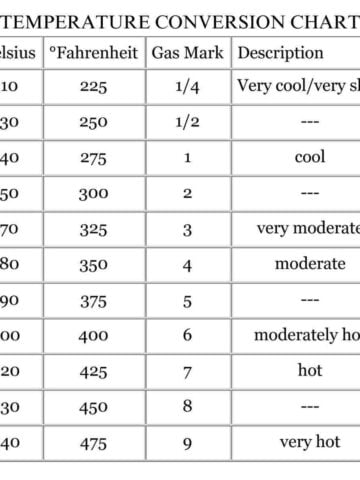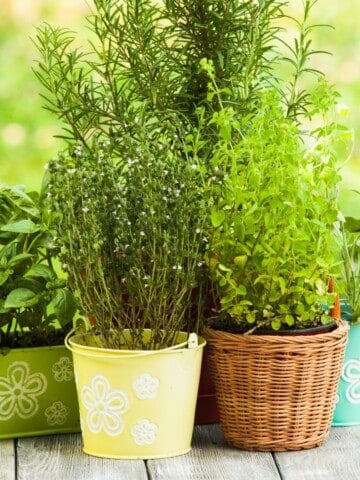A French Cuisine Glossary
French cooking terms are often seen in recipe books and restaurants. They are there to guide you with the dishes, but can sometimes be confusing if you don't know what they mean. Here is an alphabetical list of common food words that will help!
How often have we seen a recipe we like, but are not sure what the cooking terms mean?
Here is a list of the most common French cooking terms to help you with your recipes and understanding restaurant menus.
For Your Convenience French Cooking Terms In Alphabetical Order
Acidulate: To make foods or liquids slightly acidic by adding vinegar or lemon juice to it.
Affriander: A French term for an appetizing presentation to a dish.
Affrioler: A French term for enticing one’s guests to the table with hors d’oeuvres and small samplings.
Arroser (baste): To spoon melted butter or fat or liquid over food as they cook.
À La: A French term meaning “in the style of”
À La Carte: A French menu term referring to the price of individual items. One of the French cooking terms most often seen on the menu in restaurants.
Amuse Bouche means ‘amuse the mouth’ – small samples of food offered before a meal to whet the appetite.
Aperitif: a light alcoholic beverage served before a meal.
Assation: A term for cooking foods in their own natural juices without adding extra liquids.
Au Bleu: A French term for the method of preparing fish the minute it has been killed – the fish is plunged into a boiling court bouillon, which turns the skin a metallic blue color.
Au Jus: A French term for meats served in their natural juices.
Au Poivre means ‘with pepper’, either coating the meat with peppercorns or serving with a pepper sauce.
Baguette: the word means “wand”, and this is the cheapest and most popular bread, varying from excellent to mediocre. It will last a day at the most, and comes in three forms: ‘ordinary’, with a crisp golden crust; ‘baguette moulée’, manufactured in an industrial bread oven, and recognized by a fine lattice pattern on the underside; ‘baguette farinée’, which is paler in color because the crust has been covered with flour before cooking. Your own French Baguette.
Baguette (or pain) aux céréales: a slightly healthier version made from wholegrain flour with added fiber from seeds and grains. Also comes in the form of a pavé — a loaf.
Bain-marie: A water-bath for oven cooking delicate terrines and desserts. Usually the dish is placed in a roasting tin half filled with water in the oven.
Baste: To spoon, brush or pour fat over a roast as it is cooking to add flavor and to glaze it.
Batard: a half-length baguette.
Beurre Manié: A paste made by mixing equal quantities of butter and flour. It is stirred into stock or sauce at the end of the cooking to aid thickening.
Beurre noisette: A simple sauce made by cooking butter until it is brown and ‘nutty’
Blackened: A technique where meat or fish is coated with a seasoning and then seared in a cast-iron skillet in which oil has reached its smoking point.
Blanch (blancher): To plunge food into boiling water and boil it until it has softened or is partially cooked. It is used to remove a strong taste from some foods such as cabbage or onions.
Blanchir: To place in boiling water so as to whiten and loosen the skins, usually of meats.
Blanquette: A meat stew, usually of veal, with an egg and cream sauce and garnished with onions and mushrooms.
Blend (mélanger): To mix less vigorous than beating, using a fork or spoon.
Bleu: French term for a cut of meat cooked until is only warmed through or rare.
Blondir: A French term for lightly browning foods in a fat.
Boil (bouillir): Liquids heated until they are rolling and sending up bubbles. A slow boil is when there is only a bubble here and there – to simmer. When there is very little movement in the water – to poach.
Bon Femme: A French term used to describe food cooked in a simple or rustic manner.
Bouquet Garni: This is one of the French cooking terms most often seen. It is a bunch of herbs used to flavor dishes usually consisting of parsley, thyme, bay leaf, and sometimes celery leaves tied together with kitchen string or in a nylon produce bag.
Braise (braiser): To brown food in fat then cook in a casserole with a small amount of liquid.
Brioche: a buttery sweet bread, perfect for bread-and-butter pudding, although it rarely lasts that long! Try this lovely French Brioche bread.
Brulée: A French term to describe ‘burnt’ as in crème brulée recipe..
Brunoise: A French term used to describe a specific cut or mixture of vegetables – usually small dice, braised in butter.
Capers: Are flower buds from the Caper bush, also called Flinders Rose. The flower buds and caper berries are pickled and used in dishes for flavoring. They have a mustard and black pepper taste.
Cartouche: Is a piece of parchment paper that is used to keep (usually meat) submerged when braising or placed on the top of sauces or pudding to prevent a skin from forming on the top.
Castor Sugar: Is a very fine sugar between the consistency of white granulated sugar and icing sugar (or powdered sugar). To create your own castor sugar buzz granulated sugar in the blender until finer but not powder (being careful not to breathe in the dust).
Champignon: A French term for any edible mushroom or the particular dish they accompany like Buttered Chanterelles
Charcuterie: Products such as salami, sausages, pates and similar forcemeats usually based on pork and pork offal.
Court bouillon: A mixture of water, herbs, vegetables, and either wine or vinegar, used mainly for cooking fish. You can see this method used in this Poached Salmon Recipe..
Couronne: bread in the shape of a ring.
Croquettes: Small fish cakes or meat and/or vegetable rissoles.
Deglaze (deglacer): After meat has been sautéed or cooked in a pan, liquid is poured in and the bits of meat and juices scraped into the liquid. This deglaze is important for a good sauce.
Degrease (degraisser): To remove fat from the surface of hot liquids.
Dice (couper en des): To cut food into cubes the shape of a dice.
Farci: Stuffed.
Ficelle: a long and thin baguette, with a lot of crust. The ficelle does need to be eaten promptly as the inside dries out very quickly.
À la Ficelle: Suspended by a length of string as in Ficelle Picarde, which is covered in shredded cheese. Ficelle means string in English.
Flambé: is a cooking procedure in which alcohol is added to a hot pan to create a burst of flames as in Crepes Suzette Flambé Classic. The word means "flamed" in French. (From Wikipedia)
Flute: a fatter baguette, twice the size of a baguette, with a higher ratio of dough to crust.
Fold (incorporer): To blend a delicate mixture such as egg whites when beaten e.g. Learn how to create a perfect soufflé..
Fouetter (Beat): To mix food or liquid thoroughly using a spoon, fork or whisk etc.
Fricassée: In French terms means cooking chopped food in its own juices and commonly now in a white sauce. Lend your skills to this delicious recipe Chicken Fricassée.
Fumet: Concentrated fish stock.
En Gelée: Cold, jellied.
Gibelotte: Meat stewed in wine in a casserole.
Au Gratin: To brown the top of a dish either in the oven or under a grill. Usually of cheese like Cauliflower au Gratin or breadcrumbs mixture.
Julienne: To cut vegetables or citrus rind into short, thin strips. Vegetables used to garnish are often cut in this manner to decorate.
Lardon: Are thin cubes or strips about ¼ inch thick of bacon fat from pork, used to add flavor to dishes.
Manons: Chocolate filled with fresh cream.
Maquereau: mackerel
Marc: grape spirit
Marcassin: young wild boar
Marchand de vine: wine merchant
Marinate: To soak foods in a liquid so as they absorb the flavor for example beef marinated in red wine. Again this is one of the French cooking terms we most often use.
Mariné: marinated
Mariniére: Moules à La Marinière (Mussels In Wine Sauce) A delicious French dish with mussels cooked in white wine sauce.
Mesclun: A salad mix of young lettuce leaves and herbs such as rocket, lamb’s lettuce, dandelion leaves, basil, chervil and endive. Traditionally found in the south of France.
Mirepoix: A flavoring employed mostly in braising meat, which is usually composed of finely diced or chopped carrots, leeks, onions, celery, lean bacon and bay leaf and thyme, all cooked gently in oil or butter.
Nap, napper: To cover food with a sauce
Pain de campagne: ‘country’ bread, suitable for eating with meats, cheeses, and soups with a thick crust and dense wholegrain dough, and certain not to last more than a day.
Pain complet: wholegrain loaf.
Pain levain: sourdough bread. Slightly acidic, and goes well with strong flavors such as smoked salmon and foie gras.
Pain de mie: is the closest you’ll get to a traditional British (or American) loaf, though you will rarely find it in boulangeries—you’ll have to try the supermarket.
Pain aux noix: as the name suggests, bread spiced with nuts
Pain de seigle: rye bread. Less intense rye flavor than its northern European equivalent, because it is diluted with white flour.
Pain au chocolat is a light buttery individual bread flavored with chocolate, sometimes called a chocolatine.
Pastis: A French aperitif with the flavor of aniseed. It is most often served with water which causes it to cloud up giving it a "muddled" or "hazy" look, hence the French word for this look is "pastis".
Paupiette: Thin rolled, stuffed escalope slice of meat.
Pommade: Softened or whipped butter to be added to a dish.
Raclette: Is a type of French cheese eaten by melting the face of the cheese and then scraping the melted part on top of select food items on a dinner plate. The term raclette derives from the French word racler, meaning "to scrape". See what a fabulous meal this can make for a special meal or dinner party with a Raclette Cheese Grill.
Roux: A mixture of flour and butter, or fat, blended into a ball or glob and used as the basic thickening agent for sauces. This method prevents the flour from lumping.
Sauté: To fry lightly and quickly in a small amount of butter or fat, tossing and turning, during the cooking process, instead of allowing to sizzle.
Velouté: A thick cream soup. Potage Veloute Aux Champignons (Cream of Mushroom Soup)
Didn't find the word(s) you are looking for? Try Gayot.com
Once you have an idea of what the French cooking terms mean it will make it much easier when making your wonderful French recipes.
You will find French cooking terms used in many cookbooks and it is useful to have a knowledge of them.
I do hope these have helped a little.
You might also find French Food Words For Travel and Oven Temperature Conversion useful as well.
Not sure where to go from here? Start with How To Season Food, or Traditional French Recipes.






If you tried this recipe please let us know.